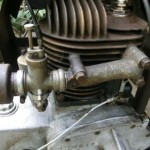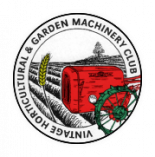Forum Replies Created
-
AuthorPosts
-
January 7, 2014 at 7:35 pm #4968
 wristpinParticipant
wristpinParticipantIt’s a Ginge (pronounced Gingah) came in two widths and had a plastic grass collector under the handlebars. Not many collectors have survived as they were prone to uv deterioration, brittleness and disintegration! I’ve got one minus collector that my Dad bought around 1960 and the local Antiques Centre (junk shop) had a complete one a couple of months ago – I resisted the temptation!
At present they have a Webb Witch with high cut side wheels and no front roller. Never seen a roller driven Webb push mower with high cut wheels but they look original and not a diy adaptation.January 6, 2014 at 8:42 pm #4946 wristpinParticipant
wristpinParticipantLeave it as it is!
January 6, 2014 at 4:36 pm #4933 wristpinParticipant
wristpinParticipantNever seen one suffer from heat, don’t think that those old Slopers ever get hot enough to cause a problem. If your engine has an ignition switch in the cowling just to the left and level with the top of the recoil starter the wire to that usually shares those clips with the fuel pipe.
From memory the HT lead goes upwards and under the fuel tank but all my Sloper engined machines are well buried in the shed for the winter!January 6, 2014 at 12:56 am #4926 wristpinParticipant
wristpinParticipantI believe that the original was unreinforced clear plastic but most clear plastic pipes are suffering from the current ethanol adulterated fuels. They either go hard or floppy depending on the particular plastic. The (usually) yellow Tygon pipe seems to be the most fuel resistant around at present. The original routing in the clips under the flywheel cowl can be a bit of a pain so if concours originality is not important it is easier to route it under the fuel tank over the left of the engine (as viewed from the operating position).
January 5, 2014 at 10:58 pm #4924 wristpinParticipant
wristpinParticipantWill be a good test of JB Weld. In theory if everything remains tight and JB Weld does not break down to dust it should all stay solid.
As long as your taper is a nice snug fit you should be OK as it’s the torqued up taper that does the work. The key and keyways are there mainly to position the flywheel for correct timing.
January 5, 2014 at 9:36 pm #4921 wristpinParticipant
wristpinParticipantWere they the same engine as Tecumseh? Didnt they also have problems with conrod failure, if used at low revs for longer periods the dip/splash lubrication wasnt sufficient. They also didnt have any white metal bearing as such, the alloy conrod fitted straight on the crank.
Their con rods ran straight onto the crank with no separate shell, but so did Briggs and both used splash lub on their horizontal crank engines. My experience was that so long as the oil level was kept up to the mark Aspera/Tecumseh/Tecnamotor were ok. Way back I ran a Webb 24 with a trailed roller seat mowing over half an acre a week for several years with no trouble.
On the question of valves I would just say that although an Aspera lump may appear to have good compression etc it’s amazing what a difference a perfectly sealing and set up valve train makes.
As the author of one of my favourite small engine publications says ” the technician who is valve critical will always have a better record of success than one who takes a near enough approach”January 5, 2014 at 6:33 pm #4909 wristpinParticipant
wristpinParticipantThese engine were as a general rule awfull, very occasionally you’d get a good one but not often.
Think that you are being just a touch hard on the poor old Aspera although it has to be acknowledged that they were not as bullet proof as Briggs etc. One thing for certain is that they didn’t tolerate poor maintenance, particularly bad valve seating and gapping. Unless the valves are in good order you can fiddle around with carb settings all day to no good effect. Bite the bullet and reface and reseat the valves and reset the gaps. Be particularly careful that when setting the exhaust valve clearance the valve is well clear of the automatic compression release.
Another area to watch out for is warped carburettor/inlet manifold flanges allowing air leaks. More prevalent on vertical shaft engines but worth a check all the same.January 5, 2014 at 12:08 pm #4886 wristpinParticipant
wristpinParticipantI believe that their tractor shaped one was built by MTD so it’s possible that this one was also sourced from the same manufacturer. Presume that there is no serial number anywhere.
January 3, 2014 at 12:08 pm #4784 wristpinParticipant
wristpinParticipantTalking of home made motorcycles. BBC2 9.00 tonight, James May’s Toy Story – building a full size motorbike from Meccano. May be worth watching.
January 1, 2014 at 8:49 am #4691 wristpinParticipant
wristpinParticipantThere was the Suffolk Centaur and a similar Qualcast branded machine and latterly the OMC Lrawnboy
December 30, 2013 at 6:05 pm #4643 wristpinParticipant
wristpinParticipantI have seen these mowers advertised before and there is no denying the standards that they are restored to, but I can’t help wondering if they have actually sold any mowers at these prices?
Can’t ever see mowers of that era being a ” money no object, must have item” regardless of how original or painstakingly restored! However, never say never………!
December 28, 2013 at 2:51 pm #4581 wristpinParticipant
wristpinParticipantThanks, have replied.
For reasons unknown I seem to no longer be getting email notifications of private messages. Not aware of changing any settings!December 27, 2013 at 9:33 am #4562 wristpinParticipant
wristpinParticipantAh, just the support bearing for the sprocket on the other side.
Page 11 in the parts list.December 26, 2013 at 11:59 pm #4554 wristpinParticipant
wristpinParticipantIn the late 60s I bought a gadget from the now defunct Rupert Ledger company that connected to the HT lead and a good earth and emitted a tone which changed at the point where the contact breaker points opened and closed. This leaves the hands free to hold/tighten the flywheel – no fag paper required. Once one gets used to the change of tone it gives a good indication of clean/dirty points. A sharp change equates to clean points and a “smeared” change, dirty. No change of town and there is definitely something amiss such as a shorted capacitor.So as well as setting timing it is a useful diagnostic tool.
Mine is in a substantial metal case about twice the size of a cigarette packet but I’m sure that with modern electronics someone with the right ‘ology could reproduce and miniaturise it now.December 26, 2013 at 10:01 pm #4549 wristpinParticipant
wristpinParticipantSend an image of said protruding cylinder on back of chain case – can’t envisage it at present but will see if the parts list reminds me.
Second thoughts do you mean on the left hand side top of the chain case. If so it is the dog clutch for the cutting cylinder drive to allow the machine to be motored without the cylinder running. Pull it out against spring pressure and rotate it and it should lock out. Have known them to be worn and refuse to stay out or to jump and rattle and not stay in drive under load.https://www.dropbox.com/s/nuammfxdhmyseeq/Atco%20HD28-34-Villiers0001.pdf
-
AuthorPosts
